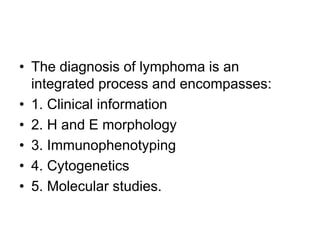New PPT Presentation.ppt
- 1. ? The diagnosis of lymphoma is an integrated process and encompasses: ? 1. Clinical information ? 2. H and E morphology ? 3. Immunophenotyping ? 4. Cytogenetics ? 5. Molecular studies.
- 2. ? Tissue sample sent to the laboratory for a suspected case of lymphoma can be sent for the following tests: ©C Microscopy on appropriately fixed and stained tissue samples. ©C IHC or for flowcytometry. ©C Cytogenetic analysis by Giemsa banding. ©C FISH on cell suspensions, films, imprints or paraffin sections. ©C Molecular genetic analysis by RT-PCR or gene sequencing.
- 3. Morphological Analysis of Lymph Nodes:
- 4. ? Well fixed LN tissue cut at 3 microns and stained with H and E. ©C Cornerstone for the diagnosis of lymphoma ©C Regardless of number of advanced anicillary tests available at hand.
- 5. Points to Note Under Low Power: ? Architecture pattern of the lymph node: ©C Diffuse ©C Nodular/follicular ©C Mantle zone ©C Marginal ©C Interfollicular ©C Sinusoidal ©C Heterogenous
- 6. Points to Note Under High Power ? Cell size ? Monotonous/heterogenous ? Chromatin pattern ? Nucleoli ? Nuclear shape ? Cytoplasm
- 7. Cell Size: ? Good guide to the grade of many types of NHL. ? Poor fixation / Thick section: cell assumes shrunken apppearence. ? Excess intense nuclear staining: masks subtle nuclear details. ? Hence most impportant: adequate tissue fixxation.
- 8. Assessing the Size of Lymphoid Cells: ? Large lymphoid cells: nuclei larger than that of a histiocyte nucleus. ? Medium sized cells: comparable/slightly smaller than that of a histiocyte nucleus. ? Small lymphoid cells: nuclei much smaller than that of a ? histiocyte.
- 9. Lymphoid Neoplasm with Small Cells: ? Follicular lymphoma grade 1-2 ? Mantle cell lymphoma ? Marginal zone lymphoma ? CLL/SLL ? LPL
- 10. Lymphoid Neoplasm with Medium-sized cells: ? BurkittĪ»s lymphoma. ? Lymphoblastic lymphoma ? DLBCL (rare) ? PTCL-NOS (variants) ? NMZL
- 11. Lymphoid Neoplasms with Large Cells: ? DLBCL ? PTCL ? ALCL ? Follicular lymphoma grade 3B










